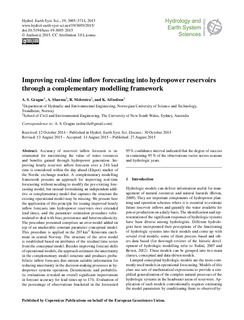Improving real-time inflow forecasting into hydropower reservoirs through a complementary modelling framework
Journal article, Peer reviewed
Permanent lenke
http://hdl.handle.net/11250/2357862Utgivelsesdato
2015Metadata
Vis full innførselSamlinger
Sammendrag
Accuracy of reservoir inflow forecasts is instrumental
for maximizing the value of water resources
and benefits gained through hydropower generation. Improving
hourly reservoir inflow forecasts over a 24 h lead
time is considered within the day-ahead (Elspot) market of
the Nordic exchange market. A complementary modelling
framework presents an approach for improving real-time
forecasting without needing to modify the pre-existing forecasting
model, but instead formulating an independent additive
or complementary model that captures the structure the
existing operational model may be missing. We present here
the application of this principle for issuing improved hourly
inflow forecasts into hydropower reservoirs over extended
lead times, and the parameter estimation procedure reformulated
to deal with bias, persistence and heteroscedasticity.
The procedure presented comprises an error model added on
top of an unalterable constant parameter conceptual model.
This procedure is applied in the 207 km2 Krinsvatn catchment
in central Norway. The structure of the error model
is established based on attributes of the residual time series
from the conceptual model. Besides improving forecast skills
of operational models, the approach estimates the uncertainty
in the complementary model structure and produces probabilistic
inflow forecasts that entrain suitable information for
reducing uncertainty in the decision-making processes in hydropower
systems operation. Deterministic and probabilistic
evaluations revealed an overall significant improvement
in forecast accuracy for lead times up to 17 h. Evaluation of
the percentage of observations bracketed in the forecasted 95% confidence interval indicated that the degree of success
in containing 95% of the observations varies across seasons
and hydrologic years.
